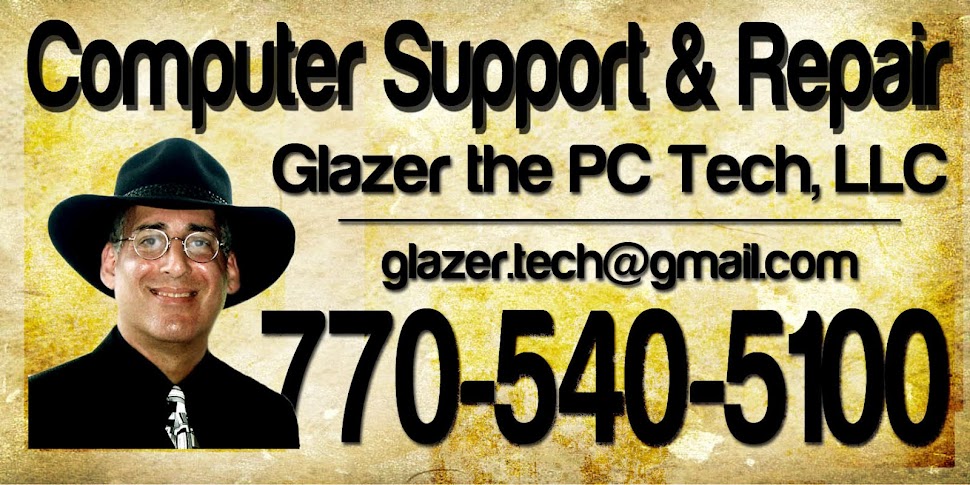arthur@glazerthepctech.com
Writing is a family tradition. Both of my daughters write and my wife has a biweekly column here in The Times. When I meet people around town, I often hear that they read our columns - and enjoy hers. It's just that mine is too technical for them to understand.
I try not to use much techno jargon, but I can't stop using the necessary terminology. I can try to help you understand it, yet I need to refer to components like the processor as such. I can't call it "the thingy that makes the computer run."
So let's have a brief primer in computing technology. There won't be a test at the end, but take notes anyway.
Since you use computers, there are certain terms you should be familiar with. It will help you when you need to troubleshoot your system. If you don't know your RAM from your ROM, F Keys from F-Stops or drag and drop from cut and paste (I could go on), then keep reading.
RAM is your system memory. The acronym means Random Access Memory. It is your computer's temporary storage in that when you power down, what is in RAM is lost.
Your hard drive is your permanent memory or storage device. When you save a document, that's where it goes. In today's PCs, you might have 2 gigabyte of RAM with a 300 GB hard drive.
ROM is Read Only Memory. That's what a DVD has when you get one with a movie on it. Your optical drive, the CD/DVD reader/writer, may say DVD ROM if it only reads DVDs.
Drag and drop is what you do with Windows files when you want to move them from one place to another. Let's say you have some photos on your desktop. Open your My Documents folder and find the My Pictures folder. Click and drag each photo on your desktop (holding the left mouse button down) on top of the Pictures icon and then let go. You just moved the photos there. If you use the right mouse button, you'll have the option of move or copy.
Cut and paste is when you highlight some text or an address to place somewhere else. Position your mouse at the beginning of the text and holding the left button down, go to the end of the text desired. Then right-click, choose Copy, or go to Edit from the top menus and choose Edit -> Copy.
Put your curser where you want to move or copy the text and then right-click again and choose Paste or go to Edit -> Paste. Alternatively you can use keyboard shortcuts Control + C for copy and Control+ V for paste.
The F Keys are the top row of keys, usually in blue. They are accessed in combination with the FN (Function) Key on the bottom left of your keyboard. They change things like screen contrast, toggle the wireless on and off or allow an external monitor. Just look at the icon on each key. Computers differ as to the function of each key.
F-stops are the aperture sizes on your camera's lens. That's another column altogether, but I did mention it.
Let's continue. You've heard about modems and routers. Some Internet service providers combine these two devices into one unit, but let's say you have two boxes. The modem, which means modulate, demodulate, gets the signal from your wall and your provider. The router spreads it around your home to various computers.
A flash drive, thumb drive, USB drive or whatever you decide to call it is that tiny storage device on your keychain. It usually holds anywhere from 1 to 16 GB. It is cheap, has no moving parts and will be the type of hard drive in computers in the very near future.
The processor is the actual chip that does most of the work. It is the CPU or Central Processing Unit. It could be Intel or AMD, single, dual or quad core. It is currently measured in gigahertz GHz (1-3) noting the speed of the processor.
Hardware is a tangible component in or on a computer. Software is a program it uses.
An e-mail client is Outlook, Outlook Express Windows Mail or Incredimail. Web Mail uses the Internet and online programs like Gmail, Hotmail and AOL Mail.
An attachment is something you send with an e-mail, whether it is a document or a photo.
Photos are often referred to as jpgs or jpegs, as that is a common file extension for a photo image (myphoto.jpg). Movies on the other hand are often called mpgs or mpegs as that is their extension. There are others for both.
If you take even this little bit of PC knowledge with you next time you computer shop, you'll know what the sales guy is talking about.
There will be a test next time.
Arthur Glazer is a freelance writer and computer technician in Gainesville. His column appears biweekly on Saturdays. Arthur welcomes your computer questions and ideas for future columns.

No comments:
Post a Comment
Got a Comment - or a quick question...